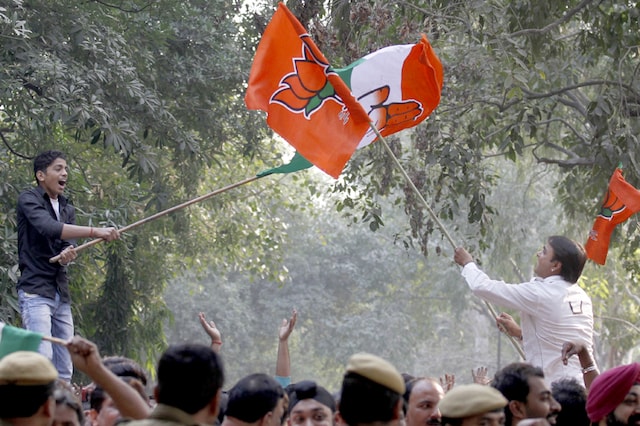90 Different Poll Battles, Not One Election in Chhattisgarh as BJP, Congress Support Dwindles
Curated By: Sudeep Srivastav
Last Updated:
Because of last 18 years of development and growth, a completely new breed of neo-rich has taken roots. This section is seeking a larger cake in the political pie.

Chhattisgarh, a new state carved out in 2000 from erstwhile Madhya Pradesh, has turned 18 - attaining adulthood or maturity in more ways than one. The traditional support base of the big players - BJP and Congress - has whittled in successive elections and the local equation prevailing in any particular constituency may decide the final outcome this time around.
Chhattisgarh broadly has 31 per cent ST, 11.6 per cent SC, 45 per cent OBC and around 10 per cent upper caste population. The STs inhabit the northern and southern region whereas the SCs are mostly confined in Mahanadi Plains. The OBCs are the largest social block and are spread across the state.
In 2000, Congress had 48 MLAs in the Assembly of 90, of which 22 were from tribal dominated Sarguja and Bastar divisions. That means a whopping 22 out of 26 assembly constituencies were won by the Congress. All of these seats were reserved for STs, except one. In the Bilaspur, Raipur and Durg divisions, out of 64 seats, BJP had won 32 against Congress's 29.
The scenario completely changed in 2003. In the first elections after its creation, BJP won 20 out of 26 in Bastar/Sarguja divisions whereas Congress took the lead in Bilaspur, Raipur and Durg divisions.
In 2008 again, the situation remained the same but in 2013 Congress regained lost ground in Sarguja and Bastar by winning 15 out of 26 seats, but failed to save its sitting seats as 26 out of 37 who contested had lost. BJP, too, suffered due to local level anti-incumbency and many of its MLA, including five ministers lost.
So what really explains the social and political churning in Chhattisgarh in the last 18 years? To get a better understand we need to sift through the data of Lok Sabha elections.
It is important to note that in 2004, 2009 and 2014, BJP or Congress managed to win 10 out of 11 seats. In these elections the voters voted either of the two parties whereas in assembly elections voting pattern is entirely different. In many seats candidates belonging to parties other than BJP or Congress have secured significant votes.
In 2018, the situation is more fluid than earlier elections. Because of last 18 years of development and growth which has certainly benefitted at least a section of the society if not all, a completely new breed of neo-rich has taken roots. This section is seeking a larger cake in the political pie.
So every assembly has more than one strong contender from both the national parties. Even Jogi-BSP alliance and AAP has attracted persons who are capable of putting up a good fight. These candidates are generally influential people within their communities and their candidature is a manifestation of smaller caste groups seeking larger share in the power structure.
If there is anti-incumbency against the state government, there is no alternative face for CM post from Congress to capitalise on that. That is why local level anti-incumbency is playing a very crucial role and ultimately the support and influence base of any significant candidate is important to assess the result of that particular seat.
For example, in Beltara, the BJP has fielded its district president Rajnish Singh, denying a ticket to its sitting MLA from the Brahmin community. Congress has fielded a candidate from OBC community. Jogi-BSP has fielded a Punjabi Brahmin candidate who is trying to make inroads into BJP’s traditional vote base.
So the Jogi-BSP candidate is expected to cut the votes of both BJP and Dalit of Congress, since he is contesting with BSP support. The result will depend on his performance.
In Akaltara, Jogi’s daughter-in-law is contesting on a BSP ticket and attracting good response. The BJP candidate is also strong here. The outcome will depend on how sitting MLA of Congress fares. If he manages to hold on to traditional Congress votes, BJP will get a fillip. Otherwise, Jogi’s daughter-in-law will have a fair chance. A perfect three-cornered contest gives Congress a chance to retain the seat.
In Khairagarh, Congress has fielded its sitting MLA but Jogi-BSP has put up former Congress MLA Devvrat Singh. BJP stands to gain from this division in the Congress vote.
In a nutshell it can be said that Chhattisgarh is witnessing 90 different elections rather than one single state election.
The author is a lawyer and a political observer. Views expressed are personal.
Edited By: Aakarshuk Sarna
Location:
DC vs GT, IPL 2024 in Photos: Rishabh Pant's Unbeaten Knock Puts DC Over The Top as GT Lose Last-Ball Thriller By 3 Runs
CSK vs LSG, IPL 2024 in Photos: Marcus Stoinis' Herculean Century Leads LSG to Sensational 6-Wicket Victory Over CSK
Ankita Lokhande, Karan Singh Grover Up The Glam Quotient At Arti Singh's Sangeet Ceremony | Photos
What A New US Military Aid Could Mean For Ukraine's War Against Russia | In GFX
Trouble for Virat Kohli as New Challengers Emerge for Rohit Sharma's T20 World Cup Opening Partner
More Latest News
SRH vs RCB Live Score, IPL Match Today: RCB 121/2 (11 overs) Rajat Patidar Goes Ballistic as RCB March On
DC vs GT, IPL 2024 Highlights: Rishabh Pant's Fiery Last-Over Onslaught Makes The Difference as DC Clinch Thrilling 3-Run Win Over GT
MBPSE MP Board Result 2024 LIVE: 64.49% Qualify MP Board 12th Exam, 58.10% Clear 10th
Manabadi TS Inter 2nd Year Result 2024 LIVE: TSBIE Second Year Results Declared! 64.19% Pass
Manabadi TS Inter 1st Year Results 2024 Live: Declared! 60.01% Students Pass; Check Direct Link